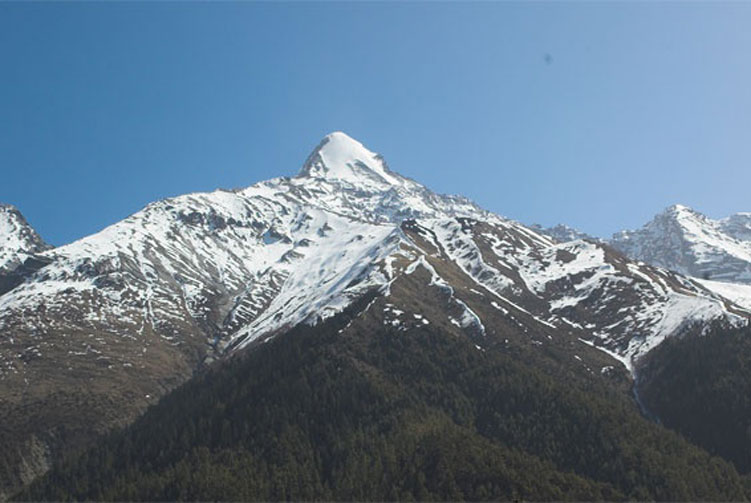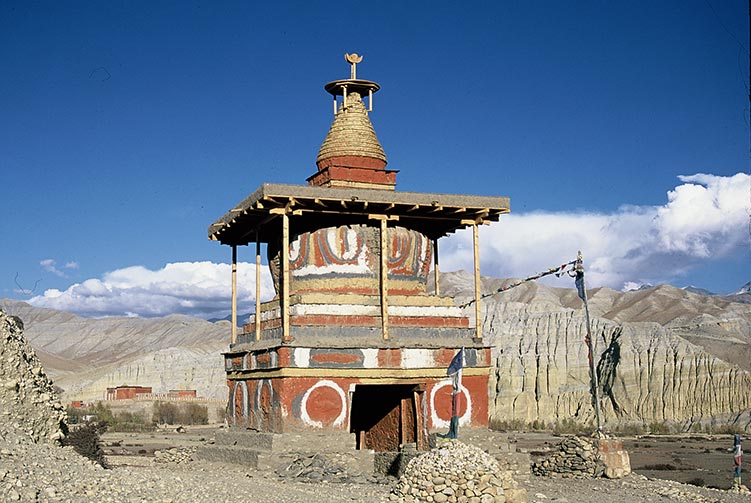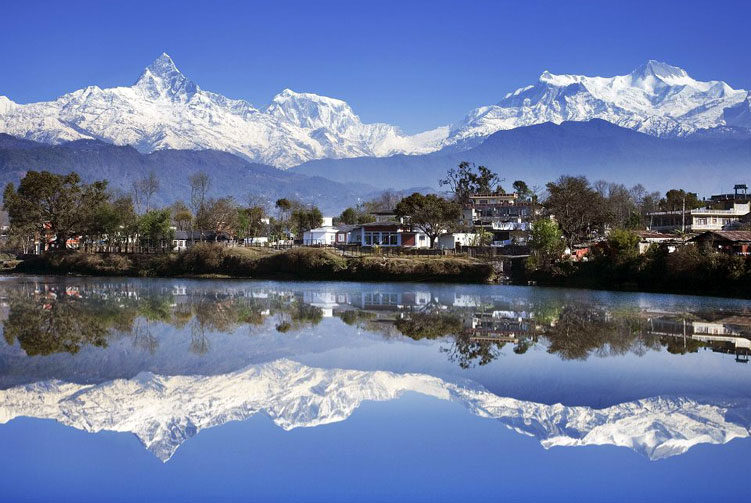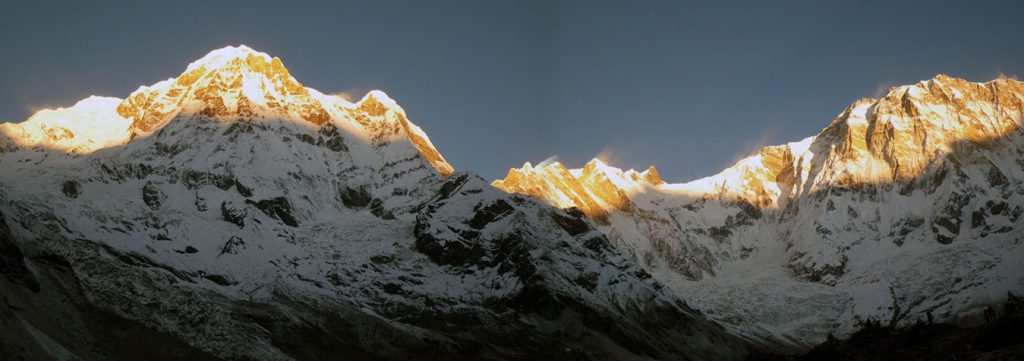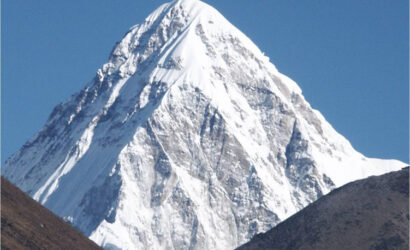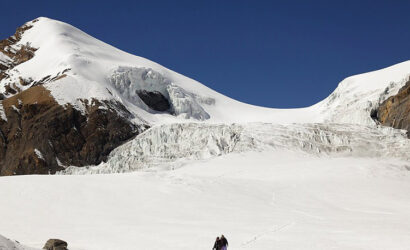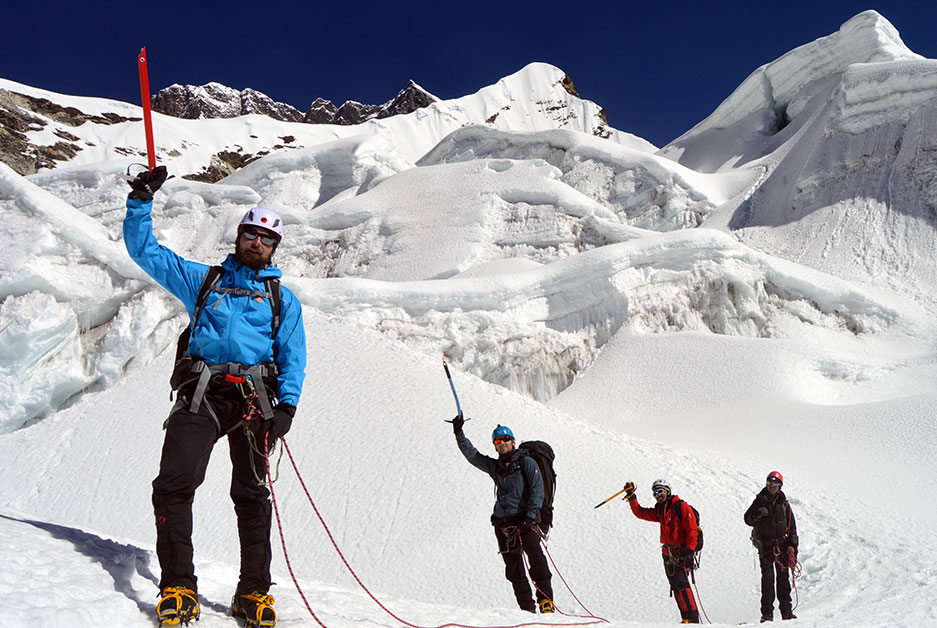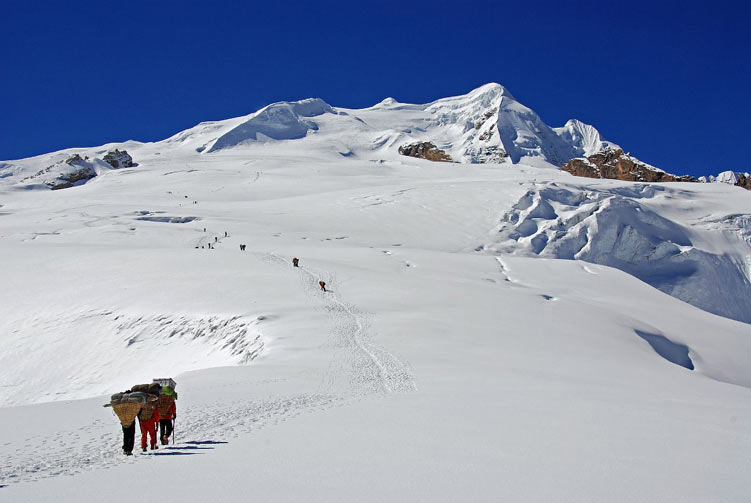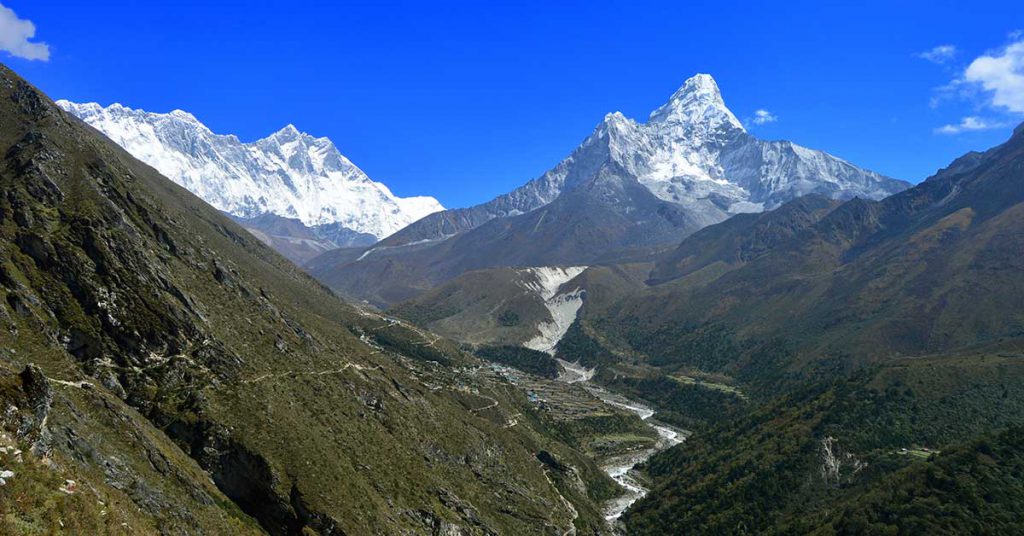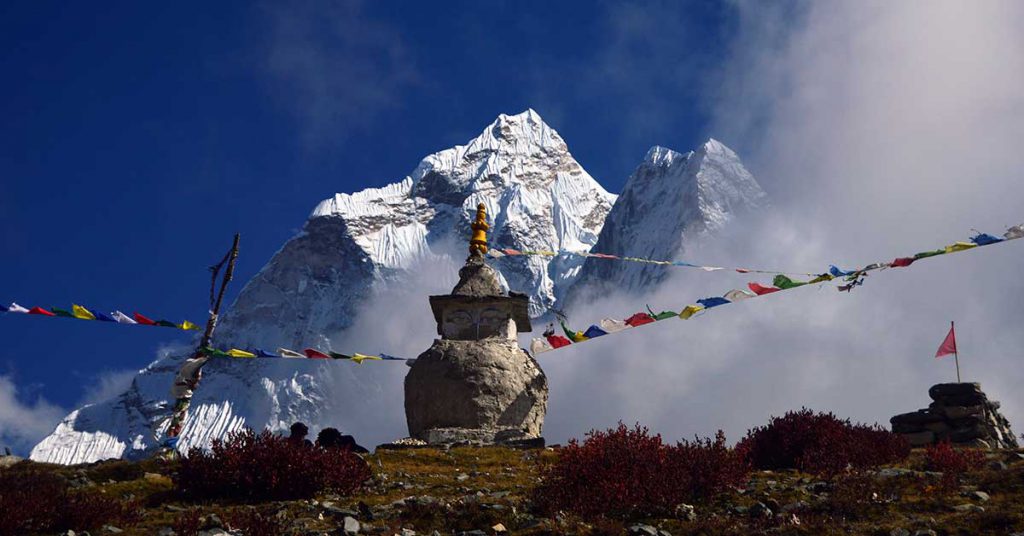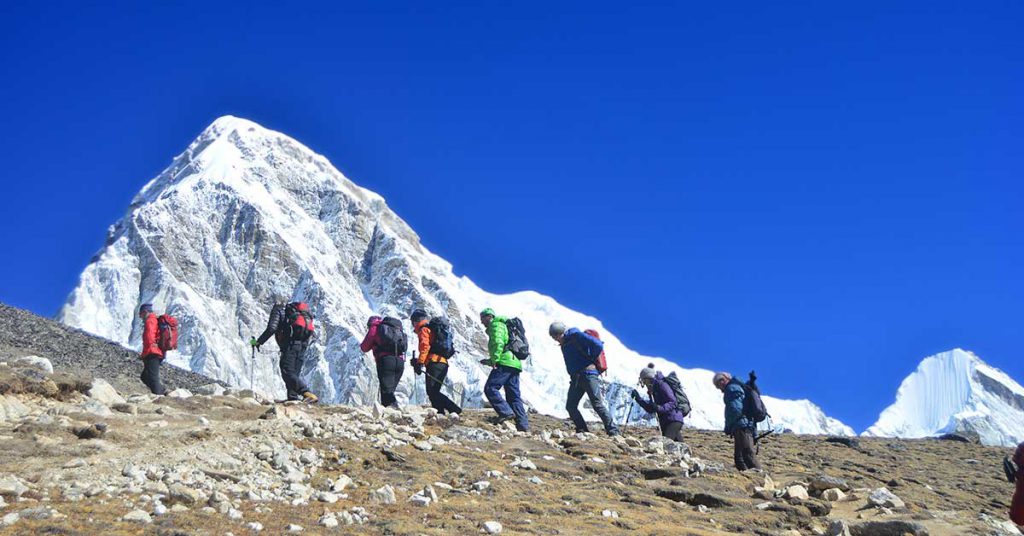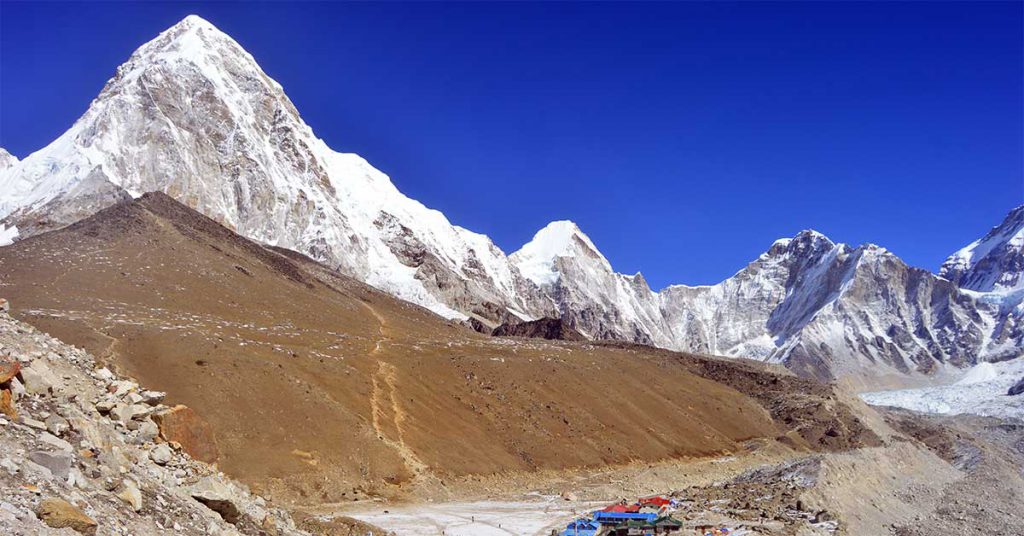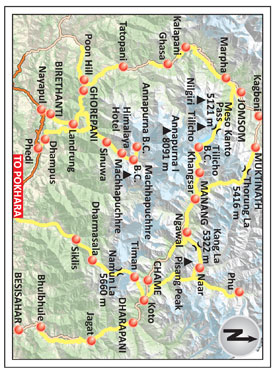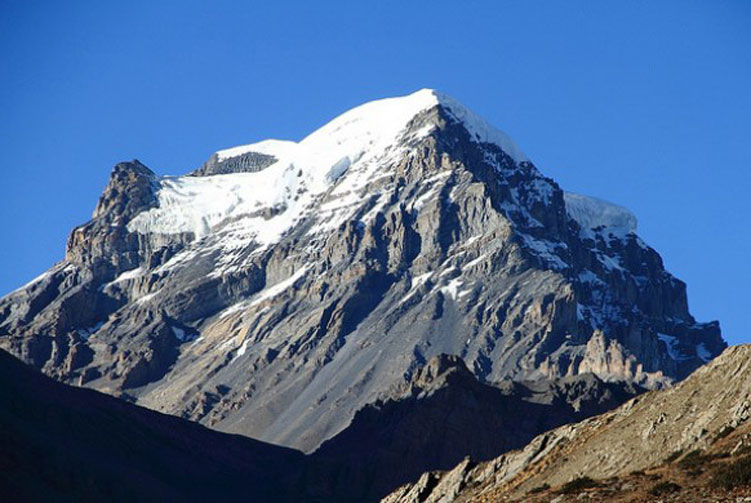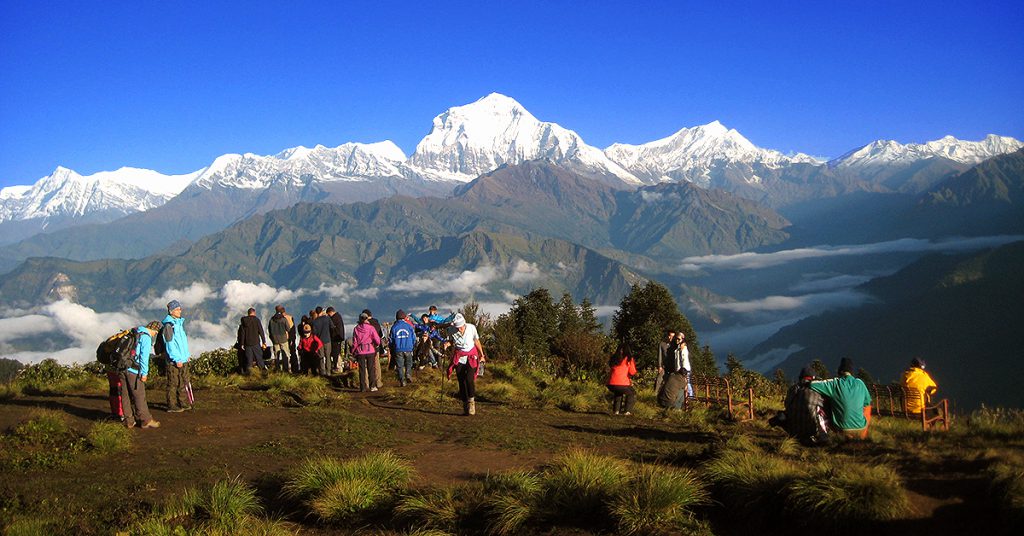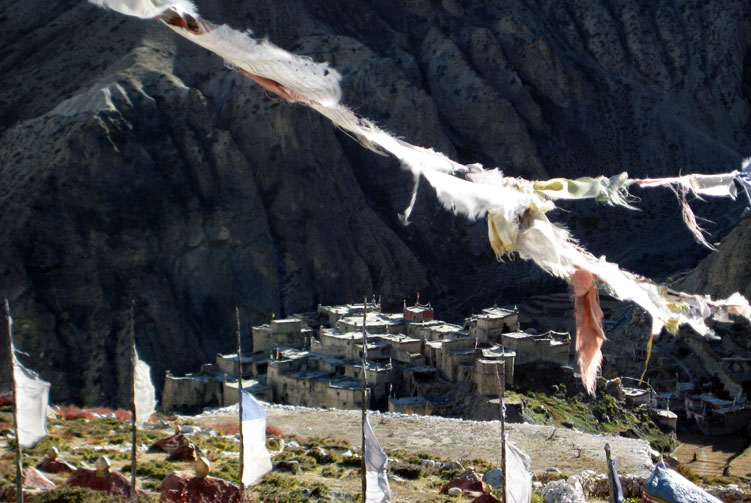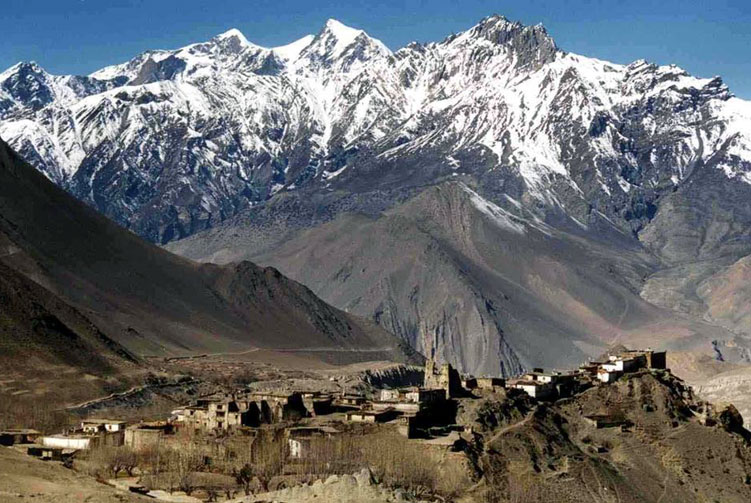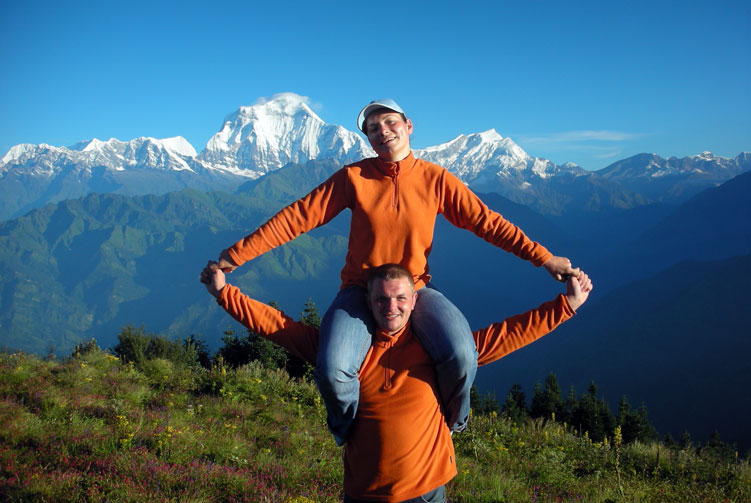Pisang Peak Climbing trip is another beautiful trekking and climbing adventure in the Annapurna range of the Himalayas. A marvelous combination of climbing the Pisang peak and trekking around Annapurna Circuit, this trip is one of the most beautiful adventure trips in the Annapurna.
Pisang peak, also called Jong Ri, that lies in the Annapurna region is a beautiful 6,091 meters mountain peak. This wonderful peak is reached after trekking half way through up to Pisang on the Annapurna Circuit trail and taking a different route towards the Pisang peak base camp. After a German expedition team climbed this mountain in 1,955, several climbers have already summited this peak.
Overview
Seasoned trekkers and amateur climbers can climb this beautiful pyramidal peak. Traversing the Marshyangdi River valley up towards Pisang peak only warms the adventurers up for the summit adventure. After climbing the peak, the trek continues towards Manang valley and crosses Thorong La pass at the elevation of 5,416 meters above sea level before trekking back down to Jomsom.
Trip Highlights
- Cultural Sightseeing tour of Kathmandu
- Stunning Himalayan landscapes, including the Annapurna and Manaslu mountain ranges.
- Exciting adventure, suitable for climbers with some trekking experience.
- Pisang Peak stands at over 19,000 feet (5,850 meters), offering a challenging climb.
- he journey to Pisang Peak takes you through picturesque villages, terraced fields, and serene landscapes.
- Reaching the summit of Pisang Peak (Imja Tse) at over 20,000 feet is a major accomplishment.
Itinerary
Today is the day of your arrival in Kathmandu, Nepal. As soon as you come out of the Kathmandu airport, you will find our representative waiting for you in the waiting area right outside the arrival lounge. You will be warmly greeted and welcomed by the representative and led to the vehicle. Our vehicle will take you to the trip hotel, most of the time in Thamel, that is 20-30 minutes drive, depending upon traffic, from the airport.
Enjoy your breakfast at the hotel. We come to take your for a wonderful cultural heritage tour of Kathmandu valley. As part of the tour, we are going to visit four of the UNESCO Heritage monuments in Kathmandu valley. The places we visit today are incredible mixture of culture, history, spirituality, art and stories. Overnight in Hotel.
Swoyambhunath
Believed to have been created on its own, this Budhhist stupa is the oldest of all the monuments in Kathmandu valley. Standing atop a small hillock, Swoyambunath, known as monkey temple amongst tourists, provides a fascinating view of the valley, surrounding hills and snow-capped mountain at the distance on a clear day.
Patan Durbar Square
One of the three medieval palace squares, Patan Durbar Square holds its medieval art and architectural grandeur. Amazing skill of the artisans is evident in each and every building that stands in the square. The square comprises of medieval palace, temples and museum.
Pashupatinath
This site is the most sacred Hindu temple area in the country. But, as the temple is strictly a Hindu only area, non-Hindu tourists go there to watch the unique Hindu cremation rituals on the bank of River Bagmati. The death rites of Hindu family there are so engrossing and heart-touching which make you feel the moment. It’s not any kind of intrusion in being there and watching somebody being cremated in an open ground. It’s a great cultural experience.
Boudhanath
This giant Buddhist stupa is considered as the biggest one in the world. This small square with giant shrine has a powerful presence of the spiritual vibrations. It’s an important pilgrimage site for the people following Tibetan Buddhism.
It is a long day of drive to our trekking region. We drive to Besi Shahar, 173 km west of Kathmandu, by bus. We drive along the Prithvi Highway that passes through several beautiful towns with views of incredible rural life in Nepal. We can also enjoy the view of snow-capped mountains at distance. The highway, at most of its stretch, goes along side glacial rivers where we can see rafters enjoying the rapids of water. We reach Besi Shahar to change the bus to a local jeep to drive to Syange past Bahundanda on 30 kilometers of dirt road. We check into a lodge and spend time lazing around.
We start the trekking journey on the Annapurna Circuit Trekking trail today. We get ready for the walk after breakfast and set out for an exciting day of trekking on the mountain trail. Our walk goes higher along the Marshyngdi river valley towards Dharapani village. The trail brings views of awesome landscape. We walk past the beautiful villages of Jagat, Chamje and reach Tal village on the bank of Marshyangdi River. After crossing Marshyangdi River over a suspension bridge near Tal village, we ascend to Dharapani to stay overnight.
On the second day of trekking on the beautiful Annapurna Circuit route, we are heading to Chame. Beautiful views of Manaslu and Annapurna II must make our day joyful. Other than the mountains, the landscape and the life style of the region are fascinating too. As we go higher, we feel the change in vegetation. With enough breaks along the way, we eventually reach Chame village to spend quiet time lazing around.
We are gaining elevation on each day of our walk and can feel the change in the landscape, vegetation and life style as we go higher. Our trek for the day takes us to beautiful village of Pisang that is used as the gateway village for Pisang Peak climbing adventure. The stretch today brings the views of mountain peaks right from Chame. We can enjoy the view of Annapurna II and Manaslu from Chame and Annapurna IV and Lamjung Himal as we advance along on the trail.
It’s day we trek to Pisang peak base camp for our Pisang peak climbing adventure. Our trek today takes us for over 1,000 meters of elevation gain when we reach the base camp. The trail passes through tiny villages, wooded parts and pastures. We will make it to the base camp a little early in the afternoon so, we will have plenty of time to soak into the atmosphere of base camp. Once we settle into our camp, we can take some strolls around to enjoy the charm of the place and also to acclimatize with the growing elevation.
It is another day of big elevation gain, of another about 1,000 meters, when we trek up to the high camp. The adventurous day takes us up in the mountain where we plod up towards the destination for the day. Once we reach the high camp, we settle into our camp and spend the day praising the views and nature and adjusting with the increasing elevation and decreasing level of oxygen in the air.
As the main day of the trip, we get ready early, much before the day light breaks, for the summit climb. The rocky face of the mountain brings us a tough challenge to climb through where we need to use fixed ropes and main rope to climb. As the struggle up is over and reach the top, we are greeted with spectacular views of the mountains in the vicinity. We enjoy the view and the moments at the top the most before descending all the way back down to base camp.
It’s an extra day to compensate any possible delays on the summit climb. If we do not use this day, we will trek to Manang today.
If we use the contingency day, we trek to Manang today. We trek along the trail towards Manang valley and pass through tiny and beautiful villages and wooded sections. When we reach Manang village we will have time to explore around the beautiful village.
We relish our delicious breakfast at the lodge in Manang and get ready to leave the beautiful village behind. Our trek for the day takes us to Letdar Phedi. The trail to Letdar brings us wonderful views of the mountainous landscape that looks completely different than the one in the lower elevation that we walked past. After about five hours of traversing the trail section, we reach our lodge in Letdar Phedi.
We leave Letdar after breakfast and trek towards Thorang Phedi. It is just a short trek of about two hours to Thorang Phedi where we take a good rest to proceed towards high camp. The trek to Thorang High Camp will be another good hour of struggling uphill. We will have spectacular view of the mountains from the high camp and around.
It’s a challenging day today but definitely a worth taking it. Our day starts before the break of the dawn higher towards the pass. About three hours of slow paced struggle towards Thorang La, through several false passes along the trail, eventually takes us to the spectacular pass that stands at 5,416 meters above sea level. We spend some moments there taking pictures and enjoying the view around.
Later, we descend all the way to Muktinath where there is a beautiful and sacred temple for Hindus. We will have plenty of time to explore Muktinath area as we reach there early afternoon.
We walk on the wonderful landscape of lower Mustang region along the stretch of Muktinath to Jomsom. Initially, the trail descends to Kagbeni village on the bank of Kali Gandaki River through several beautiful places with spectacular view. From Kagbeni onwards, we trek along the Kali Gandaki River to Jomsom. The trail can get windy during the afternoon as it lies in the valley between two gigantic mountain ranges Dhaulagiri and Annapurna. Once we reach Jomsom, we can laze around the beautiful town.
We take early morning breakfast and go to airport to board the flight to Pokhara. Another short but spectacular flight takes us to Pokhara. Once we check into hotel, we will have free time to relax and enjoy time on our own. The easy laze around helps us get some relief from the tiredness of walking through the rough and weathered terrain of upper Mustang for several days.
Early in the morning, after breakfast, we get on the bus to drive back to Kathmandu. About seven hours of overland journey takes us back to Kathmandu. Once we are in Kathmandu, we go to hotel and spend the whole day at leisure on our own. Finding relieving massage, good food, souvenir shopping, and wandering around can keep you busy for the day.
A farewell dinner is scheduled for this evening. We will let you know the departure time for dinner once we reach Kathmandu.
The final day of the trip, we drive you to airport for your scheduled flight homebound or other destination. We will pick you up 3 hours prior to your flight schedule.
The Trip Cost Includes
- Airport Pick and Drop for both International and Domestic flight by Private vehicle.
- Welcome, Farewell dinner with cultural program.
- 3 Night Tourist Standard Accmmodation in Kathmandu with B/B basis.
- Half day guided city tour with world heritage entrance permit.
- Transportation from Kathmandu-Syange by Private Jeep.
- Flight Ticket from Jomsom to Pokhara with airport TAX.
- 1 Night Tourist Standard Accmmodation in Pokhara with B/B basis.
- Transportation from Pokhara-Kathmandu by Tourist Coach.
- Standard Lodge Accommodation (best available) with twin sharing basis during the trek.
- Accommodation in Tented Camp while on Pisang peak base camp.
- Full Board Meals (3 Meals a day) while on the trek.
- Pisang Peak Climbing permits, TIMS Card fees and Annapurna Conservation Area Entrance fees.
- All necessary camping equipments; Tent, Table & Chair for climbing expedition's crew's.
- Professional & highly expertise government licensed holder Trekking/Climbing Guide.
- 2:1 Ratio porter carrying 30KG.
- All expenses of the staffs (Guides/Porters) that includes Food, Accommodation, Salary, Insurance, Equipment during your travel period.
- All the necessary trekking gear for porters like jacket /trousers, trekking shoes, gloves, shocks, sunglasses etc.
- Friends Adventure Team's Sleeping Bag, Walking Poles and Duffel Bag, to be return after trip completed.
- Comprehensive First Aid Kit.
- Arrangement of all rescue and evacuation promptly, in Worst Condition
- Pisang peak expedition group climbing gear, climbing rope, snow bars & carabineers etc.
- Trekking Map, Friends Adventure Team's special Souvenir.
- Agency service charge.
The Trip Cost Excludes
- Meals in Kathmandu.
- Any packed food/snacks, aerated drinks, energy drinks, mineral water, alcohol, cigarettes, chocolates, nutria-bars.
- All desserts, sweet things like chocolate, cake, pie, pudding.
- Items of personal nature, Laundry Expenses, Tips.
- Clothing, Packing Items or Bags, Personal Medical Kit, Personal Trekking Gears.
- Any additional staff other than specified.
- Medical and Travel Insurance and Emergency rescue by any means of Transportation including Helicopter evacuation if required.
- Rescue, Repatriation, Medicines, Medical Tests and Hospitalization expenses.
- Airfare of international flights.
- Nepal entry visa fee (Visa issuance is easy at the arrival).
- Hot shower and battery charging on the tea houses.
- Any other item not included in "Cost Includes" Section.
Frequently asked Questions
Pisang Peak Climbing involves reaching the summit of Pisang Peak, a popular mountain in the Annapurna Region of Nepal.
No, it’s not recommended for beginners. You should have prior trekking and some basic climbing experience.
The best times are spring (April to May) and autumn (September to November) when the weather is most favorable.
Yes, you should get training in essential climbing skills like using ropes and ice axes.
You can rent some equipment locally, but it’s best to bring your personal gear, especially items like well-fitting boots and clothing.
While there are no strict age limits, climbers are generally expected to be in good physical condition. It’s more about fitness than age.
Altitude sickness can occur at high altitudes and can be dangerous. Proper acclimatization, staying hydrated, and following your guide’s advice can help prevent it.
You’ll stay in tea houses or lodges during the trekking portion and eat locally available food. At higher altitudes, the options may be limited.
Yes, travel insurance that covers emergency evacuation and medical expenses is essential. Check that it also covers high-altitude activities.
Prioritize cardiovascular fitness, strength training, and endurance exercises. Hiking and trekking in your local area can also help prepare you for the altitude.
The cost can vary depending on the tour operator, the services included, and the duration of the expedition. On average, it can range from a few thousand to several thousand dollars.
Yes, many travelers choose to explore other parts of Nepal, like Kathmandu, Pokhara, or go on other trekking adventures after their peak climbing expedition.
Respect local customs, avoid littering, and use designated trails. Hiring local guides and porters also supports the local economy.
On average, you walk about 4 to 6 hours per day. One or two days can be as less as 3hrs and one or two days can be as long as 7hrs.
Yes, you can charge batteries en route. Charger should be brought. There are hot shower facilities as well. You may have to pay certain amount for both ($1-$2). Negotiate. Also, hot water facility could be free at lower elevation.
No. There are no ATMs on this trek route. You will have to draw enough cash in Kathmandu/Lukla or Namche. There are a number of ATMs in these cities. Everything is paid in Nepali rupees. So money should be exchanged before the start of the trek.
Yes. Internet can be accessed in most places. Sometimes, there might be some technical problems. Internet in Nepal is not as fast as you are used to and at times you can just lose connection.
No, it’s not strictly necessary to hire a guide or trekking agency for Pisang Peak Climbing, but it’s highly advisable, especially if you’re not an experienced mountaineer. Guides and agencies provide essential safety, local knowledge, and logistical support. They help with permits, navigation, and emergency situations, making your climb safer and more enjoyable. While it adds to the cost, the benefits of having a guide or agency often outweigh the expense, particularly for your safety and overall experience.
For Annapurna region, pay for guides range from $20 to $30 per day and porters take $15 to $25 per day.

